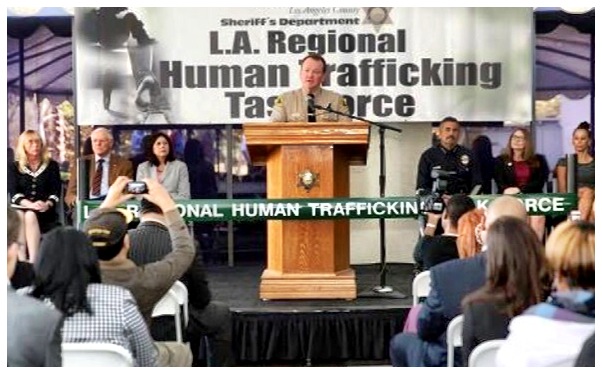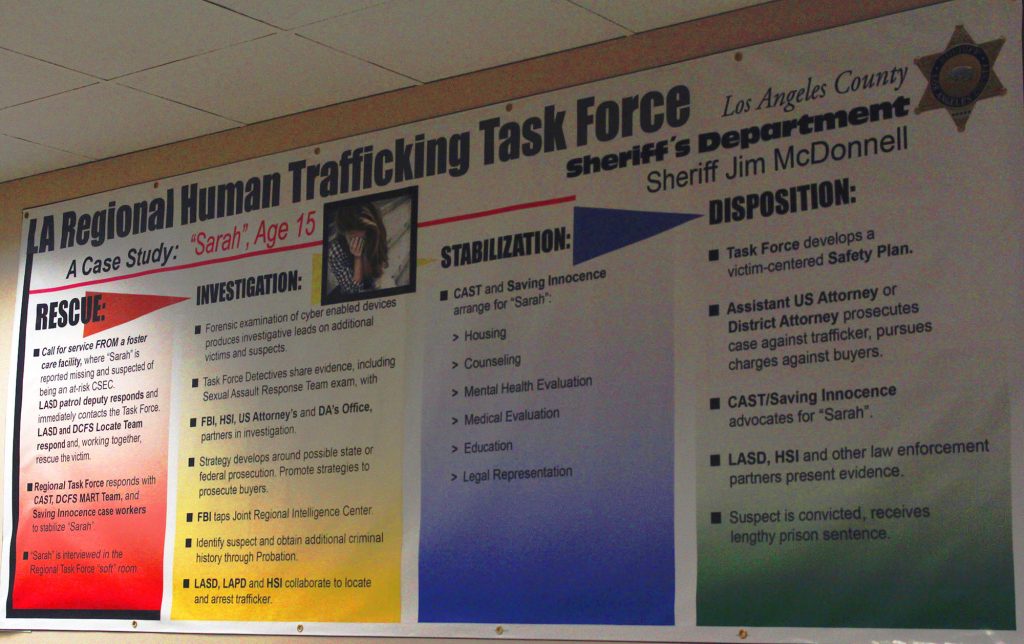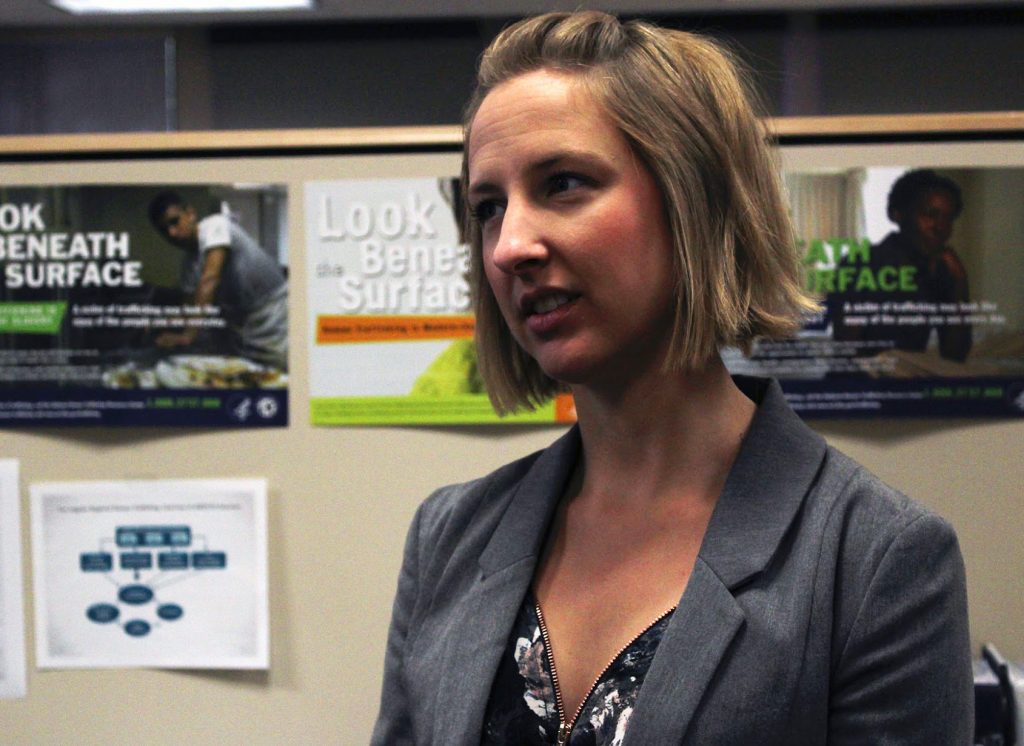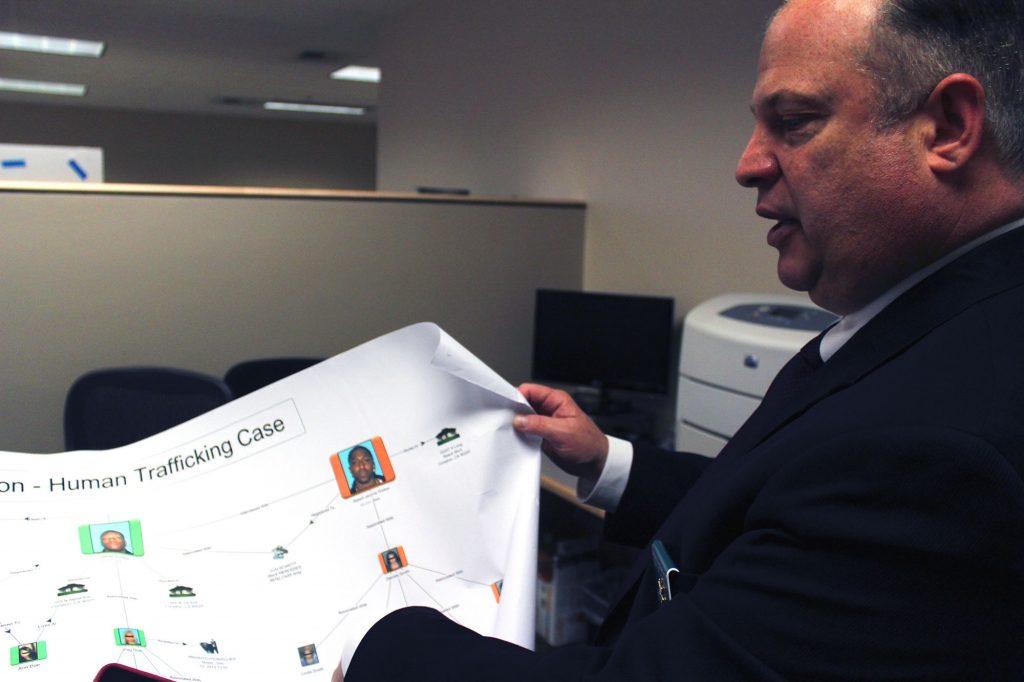The Day Michelle Guymon Confronted the Awful Reality of Child Sex Trafficking
by Kristy Plaza
Michelle Guymon is a hero in the battle against child sex trafficking.
Seven years ago, however, she had no idea Los Angeles County had a child sex trafficking problem. Now Guymon is director of the Child Trafficking Unit for the Los Angeles County Probation Department, and is part of the group that aims to make LA’s efforts to combat child sex trafficking a model for the nation.
Her connection to child trafficking began in November 2010, when she was the director of Camp Scudder, one of the two girls’ camps in the probation system.
At the time, Guymon also served on the Interagency Council on Child Abuse and Neglect (ICAN) committee, which—as the name suggests—looked at various types of child abuse within the county. At one particular ICAN committee meeting in the fall of 2010, an FBI agent gave a presentation on human trafficking worldwide, and domestic sex trafficking of minors. Guymon was startled by the domestic section of the presentation.
Today, child sexual exploitation is a significant problem across the nation. According to the National Center for Missing and Exploited Children, one in six of the 18,500 children reported as having run away from home in 2016 were “likely sex trafficking victims.” The organization defines sex trafficking victims as young people under 17 years old — boys and girls — who are “exploited through commercial sex.” Of these, “86 percent were in the care of social services when they went missing,” NCMEC says.
But back in 2010, Guymon didn’t realize the scope of the problem. “At this point in my life, the only thing I knew about human trafficking was that it happened in other countries to other kids,” she said. “It had nothing to do with me.”
She had no idea that the year before an FBI report had named Los Angeles one of the 13 most intense child sex trafficking hubs in the U.S.
“I didn’t see this happening in LA.”
Two weeks after the ICAN committee meeting with the FBI agent, the group decided to form a subcommittee on the domestic sex trafficking of minors. Yet, Guymon still wasn’t all that interested.
“I didn’t see this happening in LA,” she said.
Then her friend Judge Donna Groman of Juvenile Delinquency Court called and informed Guymon that she needed to be a part of this subcommittee. “How do you tell a judge no?” Guymon said.
An Epiphany
The first subcommittee meeting took place on Nov. 16, 2010. “I remember the date so vividly,” Guymon said, “because it was a day that had a profound impact on my life. It was here that I learned that this exploitation wasn’t something happening [only] in a faraway country. In fact, it was happening right here, in our community, to the very young women I was charged to protect.”
She realized that the young kids she’d viewed as teenage prostitutes throughout her probation career were no different than the victims from other countries the FBI agent was talking about.
“The girls at my camp that are in for prostitution are victims of sex trafficking?” Guymon thought. The concept made her head spin.
“I questioned why these young girls were doing that, not really understanding that this was something being done to them, not something they were choosing to do. I had no idea that they were under the control of an exploiter. [That] they were not out there by choice,” she said.
After this realization, Guymon talked to the now-retired chief of the probation department, Jerry Powers. “We’ve got a system full of these kids,” Guymon told him. “If they’re victims, then they shouldn’t be in detention. They shouldn’t be locked up.”
Guymon was relieved when Powers supported the creation of a new approach. When David Mitchell became bureau chief of probation, he also gave his full support.
Around this same time, Commissioner Catherine Pratt of the Juvenile Delinquency Court was making the same discovery in her courtroom, as she noticed an increase in prostitution cases. Pratt realized the minors being charged were victims of child sex trafficking.
“…her exploitation started at the age of 11 when her adopted mother sold her to support her drug habit….”
In LA County Probation, the average age for trafficked kids is 15½, but the exploitation often starts earlier, Guymon said. “We don’t see 12-year-olds in the probation system,” she said, “but in one of my early cases, a girl in a group home said her exploitation started at the age of 11 when her adopted mother sold her to support her drug habit.”
In 2011, Pratt and LA Juvenile Delinquency Court and Guymon with the LA Probation Department both applied for three-year federal grants.
Pratt proposed to open a dedicated courtroom that would focus on providing alternatives to detention and assistance for commercially sexually exploited children (CSEC). Guymon and her team applied to create a human trafficking unit inside probation, the first in the county. She hoped the grant would help her unit secure advocacy services for victims. The idea was for the advocates to help keep kids out of detention altogether, or to help shorten their detention time and get them into services and support.
Their timing was good. A year before, in 2010, the U.S. Department of Justice had published the National Strategy for Child Exploitation Prevention and Interdiction, outlining ways to address the growing problem of child exploitation, including providing grants to state, local and tribal government agencies, along with nonprofit partners.
Both got their grants. Pratt developed and supervised the STAR (Succeeding Through Treatment and Resilience) Court, and Guymon developed the human trafficking unit.
All Hands on Deck
Today Guymon’s team includes nine probation staff members, plus a supervisor, with Guymon as the head. But Guymon began her team with just three people: herself and two other probation officers.
At first, she and her two staffers were stretched thin. Getting a huge county bureaucracy — like that of Los Angeles County — to shift gears enough to move on a problem isn’t easy, even if that problem is as urgent as child sex trafficking. After a presentation by Guymon and company at a meeting of the LA County Board of Supervisors, the board became supportive. Yet the problem couldn’t be addressed by just one agency, a few nonprofit advocacy groups and a small alternative court.
On Jan. 10, 2012, the Board of Supervisors passed a motion directing many of the county’s main agencies — probation, the District Attorney’s office, juvenile courts, Department of Children and Family Services (DCFS), Mental Health (DMH), Health Services (DHS) and the Interagency Council on Child Abuse and Neglect (ICAN) — to develop a strategy for uniting the various relevant groups to address the complicated problem. The board also requested a feasibility study for making a more permanent version of Guymon’s unit within probation that was specifically devoted to helping CSEC victims.
Nearly four years later, on Nov. 16, 2015, the board passed another motion, noting that LA needed “a single, countywide body to manage coordinate, and monitor the county’s many CSEC initiatives.” No one agency could handle such a task, the board agreed. The result was the LA County CSEC Integrated Leadership Team, now known by the slightly awkward acronym of CSEC ILT. The Team was to be jointly led by probation, DCFS and the LA County Sheriff’s Department.
The ball was moved forward still farther when in September 2015 the U.S. Department of Justice provided a $1.5 million grant to the U.S. Attorney’s Office and LA County Sheriff Jim McDonnell to jointly create an LA Regional Human Trafficking Task Force that would work in partnership with other law enforcement agencies, and with CSEC ILT. The task force also partnered with the Los Angeles Police Department, the Department of Homeland Security, the FBI and 46 independent police departments in LA, uniting law enforcement to combat this issue collaboratively.
The STAR Court
One of the most important puzzle pieces when designing the multiagency effort was the court system. In that arena, LA County was one step ahead.
In 2011, while Guymon was launching her unit, Pratt had launched the STAR Court, a dedicated courtroom in Compton where Pratt now hears only CSEC cases two days each week. As an adjunct to the courtroom process, a special multidisciplinary team (MDT) meets on Wednesdays. The team—a public defender, a district attorney, an education advocate, a human trafficking advocate, a DCFS agent, a probation officer and Pratt—fosters relationships with the kids who come through the court. While most judges only see such juveniles twice per year in their courtroom, Pratt checks in with them every three to five weeks, when each kid has a scheduled court appearance to review their case and personal progress.
In between, the multidisciplinary team keeps in touch.
Probation is the leader of the team and Guymon is proud of its work. “The level of [individual] engagement that we’ve created [with kids] is what makes a huge difference in the STAR court,” she said. “We have a dedicated probation officer who is the court liaison to Judge Pratt for all matters that go through her calendar on both of those days.”
Guymon admitted that the unit doesn’t have the personnel to supervise every case. But they try to find solutions in whatever way they can, she said. If, for example, they identify a young person who they believe is at risk of CSEC, but who is close to turning 18, when they will be out of reach of the juvenile system, they introduce the youth to a probation officer with resources in the community, so that officer can help the youth once he or she is technically an adult. In other cases where the young person is already positively connected to a probation officer in their community, that relationship is folded into the protocol.
“One of the things that we know about this population is, it’s very relational,” Guymon said. “We don’t want to move them to another probation officer who they don’t know. We triage it, so we take most of the kids that are 16½ and younger; that way we have some length of time to work with them.”
In the beginning, the MDT was a group of five. Now about 17 people participate in those Wednesday meetings. And since public health issues also impact CSEC victims, in the near future a public health nurse will join the team, navigating health services such as pregnancy, parenting, personal safety, and more.
Human Trafficking Task Force
Law enforcement was also a crucial piece of LA County’s newly created system. And, according to LA County Sheriff’s Captain Chris Marks, who is now the head of the LA Regional Human Trafficking Task Force, the key to getting cops to invest in the new CSEC program was training.
“When we rolled out the first responder protocol last year to all the stations, the deputies were very receptive to this,” he said. “It’s not that law enforcement was opposed to it. They didn’t understand it. With the information and knowledge that came through [our] training, they realized what they were missing.”
Another important step, according to retired captain Merrill Ladenheim, who helped create the task force, was to make a concerted effort to cluster representatives and agents from different law enforcement agencies and community-based organizations under one roof.
The task force and leadership team work better together, Ladenheim said. “We don’t incarcerate CSEC victims, because victims don’t belong in jail. Our goal is to steer them out of probation, and into a victim-centered, trauma approach. Law enforcement [alone] isn’t the best to do that.”
One of the community organizations that partners the most actively with the law enforcement task force is CAST, Coalition to Abolish Slavery and Trafficking.
From the moment they receive a referral or crisis call, CAST and the task force wrap services around the child through an emergency first responder protocol, according to Becca Channell, CAST’s task force coordinator.
“We meet with the [victim to ensure] they get safe housing, clothing and any basic needs in that time of crisis,” Channell said. After that first step, CAST coordinates the longer-term services the young person needs, such as as health care, more permanent housing, employment training, education and more.
“They receive legal services from the very beginning,” she said. “When they were being exploited, survivors had to rely on their trafficker for income, housing and food. These services are essential to break that tie between the survivor and trafficker so they can move forward and build a life of their own.”
The coordinated effort with law enforcement is also critical, according to Channell. “It [gives] us an avenue to reach the victims.”
In addition, law enforcement provides protection, which in CSEC work is of crucial importance.
Working with the LA County Sheriff’s Department “helps us keep the victim and staff safe every step of the way.”
Once a youth turns 18, however, matters become more complicated legally, and the task force tends to step away. CAST tries to bridge the gap for young people who leave the juvenile system by providing resources and services such as food, shelter, tattoo removal and job training, as well as help with expunging their records.
CAST also offers training for law enforcement staff.
In the beginning, many in the sheriff’s department were operating under an old view of human trafficking, and had not yet understood that it was essential not to treat victims as criminals, Channell said. “We do this training with all the new people who come in from the [sheriff’s] academy to continue to shift those mindsets. It’s an ongoing process.”
In addition, she said, CAST does training with patrol officers who don’t work with human trafficking cases per se, “but are very likely to come across a human trafficking victim.”
This happens with regularity, according to Captain Marks. “A couple weeks ago,” he said, “the San Gabriel Police Department was doing an operation that led them to a motel unrelated to sex trafficking. They came across three victims and three pimps.”
The San Gabriel cops knew they had some kind of sex trafficking situation, Marks said, “because of the awareness that’s catching on. But they still needed some help. So they called our Task Force.” He paused. “It demonstrates how law enforcement is being educated and retrained on this. It’s evolving for the better.” (For more information, see the First Responder Protocol.)
Solving the Recruitment Problem
One of the greatest difficulties both the task force and the leadership team face is keeping kids from being recruited in the first place, Ladenheim and Guymon said. This is particularly problematic when dealing with youth in the probation system or in the group homes of LA’s child welfare system, where other young people who are being sexually exploited themselves will try to recruit peers by glamorizing the life. They tell other kids about all the “good” things they could have, things they might not normally get, if they join.
In order to combat recruitment, CSEC ILT conducts educational workshops in the county’s three juvenile halls. It’s a prevention curriculum, according to Guymon. The idea is to ensure that kids understand what the commercial sexual exploitation of kids really means.
“We teach kids the tactics exploiters and peer recruiters will use to get them into the life. [At the workshops] we get a lot of disclosures, where kids are saying, ‘This is what my boyfriend does to me.’ They are starting to question what their peers have told them about the life,” Guymon said.
Those young kids who are recruiting their peers are under an enormous amount of pressure by their trafficker, according to Guymon. “Many of our adult survivors say they regret recruiting other kids. They did it out of fear, to try and keep themselves safe,” she said.
Preventing victims from returning to their traffickers once they’ve been extricated is another difficulty.
“On average, the victims run back to their traffickers because of the trauma bonds or Stockholm Syndrome that has developed,” Ladenheim said.
Channell agreed. These children face various mental health issues, she said, such as attachment to the trafficker because they lack a support system, and very often do not have a home or family where they are safe. “Finding these children a safe environment where they can grow and thrive is difficult, especially when they might still have that connection or romantic feelings for their trafficker.”
“They’re vulnerable because of all these tragic things that have happened, and the trauma in their lives that puts them in a place where traffickers, pimps can sniff them out,” Captain Marks said. “[Pimps] are experts at manipulating these girls. They find them and put them in these horrible positions.”
With this issue in mind, about two years ago, the leadership team added additional training for task force members on the intersection of trauma and sexual exploitation. It’s important to include such training, Guymon said. Otherwise staff and officers often don’t understand why kids run away from placement and back to an exploiter.
For a very long time, she said, law enforcement viewed trafficked children with the lens of criminality. “We saw them as teenage prostitutes, we didn’t see them as kids who were being victimized and exploited.” And the exploitation often starts at home, or close to home.
Adult survivors, according to Guymon, often say that their personal history of child sexual abuse was more devastating to them, long term, than their exploitation by strangers. “That childhood abuse and trauma is something they still struggle with today. We help with unpacking the layers of trauma these kids have had.”
Vidhya Ananthakrishnan, a project director at the Vera Institute of Justice, explained why underlying trauma is a driving force. “Sexual abuse, family violence, it forces kids to make this choice [to run away]. They end up on the streets homeless, so they are recruited into being trafficked. It’s about survival, and trying to make the best out of a terrible situation.”
When Channell was an emergency response manager, she learned from victims how difficult it is to get out of being trafficked: “At least they know they’ll eat and know where they’ll sleep.”
The Problem of Vanishing Testimony
The conundrum of solving the child trafficking problem is exacerbated by the fact that it is so difficult to convict the traffickers.
According to Guymon, the task force struggles to get trafficking cases to court primarily because trafficked kids are terrified and not willing to testify. Without the primary evidence of victim testimony, the case against the trafficker usually vanishes.
If a child is willing to testify, then CSEC ILT works on the case with the DA’s office. They use a protocol developed specifically for victims who are witnesses in these cases to ensure the child receives protection and services throughout the process.
“What we have done in the past is to wrap as many services around them as possible. If there are any threats, intimidation or harm, we work with the DA’s office to get the kids relocated,” Guymon said.
The risk is very real, she said. When a child is testifying against someone who has sexually abused them, they run the risk of harm from their trafficker, and others, especially when the trafficking is gang-related. The trafficker is the one being prosecuted and going to prison, but the gang is still in the community.
Guymon said they are looking for better solutions, such as having the victims testify via closed-circuit television, so that they don’t have to face a trafficker while testifying.
California Senate Bill 176, approved in 2015, already allows for alternative court procedures to protect the rights of a child witness who are under 13. But youth over 13 were left out of the equation.
A subsequent bill, California Assembly Bill 1276, approved on Sept. 26, 2016, went one step further. This bill allows children 15 and younger to testify via closed-circuit TVs outside the courtroom. Guymon wishes the bill included all teenagers, although she believes it’s a good starting point. “It should have been everyone under 18 years old,” she said.
So, for now, she said, the force wraps the young people in services in whatever way is possible. “We want kids to know that if you are testifying, you’re not just a case. We will put the services, support and protections all the way through.”
Critical Next Steps
So, what should be done next to better solve the tragic problem of child trafficking?
For Guymon, more training is among the main steps most needed.
To date, CSEC ILT has trained about 12,000 professionals in Los Angeles county in the First Responder Protocol for CSEC youth — a sort of CSEC 101 that builds awareness of how the commercial sexual exploitation of children works, the vulnerability of the kids involved and what exactly puts children at risk. Those trained include probation officer, cops, county social workers, foster care providers, health care providers and more.
Guymon argues that everybody and anybody should be trained to increase public awareness. “You [the average citizen] might see something, so you need to know what to do,” she said. Her voice is professional, but also filled with an urgency often present when she talks about the kids who have become her mission.
“That’s the only way you stop things. You have all eyes on deck.”
Marks agrees. He said it is essential for the public to “truly understand the magnitude of the problem.”
To illustrate he described one of the task force’s recent sting operations in which they posted fake ads, then an investigator talked to potential customers. One ad produced 1,200 text messages exchanged with would-be buyers, he said.
“That to me portrays the problem — and the demand that exists out there. Demand is immeasurable, you can’t quantify it. You post an ad and within seconds, you’re getting a response.”
So, now the task force is putting an emphasis on “the demand side” of sex trafficking, Marks said. “This is what we’re really looking at and coming up with ways [to combat it]. Combating demand involves enforcement, of course, but also, he said, it means “ the portrayal” of what the public considers “a john” to be. “He’s exploiting a woman, [or] a child for money.”
The other part of the “awareness campaign,” he said, is getting the message out “to these kids that are already in this life.” He wants them to know that law enforcement now understands that they’ve been victimized.
“Most of the youth are girls, but boys too, [and] they don’t trust the system.” The challenge, Marks said, is to break through that lack of trust that makes CSEC children so vulnerable to pimps and traffickers. He wants trafficked kids to know they’re not going to be treated like criminals, as was nearly always the case in the recent past.
“We’re not looking at you like you’ve done something wrong. … You have a safe place to come to. We want to help you.”
This story was sponsored by the 2016 John Jay/Tow Juvenile Justice Reporting Fellowship and is the product of a collaboration between WitnessLA and the Juvenile Justice Information Exchange
All photos by Kristy Plaza unless otherwise credited.









And how does this Task Force keep running? Since it’s the “flavor of the month”, items are taken from other essential Detective Division Units this bonehead Sheriff deems non-essential in his opinion. The Human Trafficking Unit is important, but not at the cost of other Units being short handed or folding.
You are watching a politician, politic. It is that simple. He learned from Baca, don’t doubt me.
Makes perfect sense politically. The “damsels in distress “thing always sells and you don’t have to conduct raids or even show big arrest stats (which often seem to boomerang turning into inconvenient press and high dollar law suits). So it’s a natural for the bureaucrats, a way to grow the empire without too much risk. That being said, the shreiff has been at this for awhile, and it doesn’t seem to be catching on all that great. What they need is a good show trial, one with a sympathetic victim and a nasty villain, a la a 1930’s B movie.